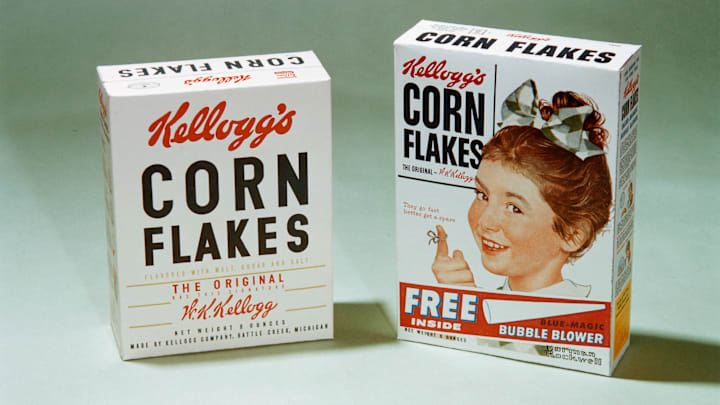
https://www.mentalfloss.com/article/20320/how-cereal-transformed-american-culture
More than a century ago, health gurus invented cereal to promote a healthy lifestyle free of sin. Little did they know, their creation would eventually be used to promote everything from radio and cartoons to Mr. T and tooth decay prevention.
Bythe mag|
Cereal has come a long way. | Steven Gottlieb/GettyImages

During the early 19th century, many Americans subsisted on a diet of pork, whiskey, and coffee. It was hell on the bowels, and to many Christians, hell on the soul, too. Some believed that constipation was God’s punishment for eating meat. The diet was also blamed for fueling lust and laziness.
To rid America of these vices, health purists spearheaded the country’s first vegetarian movement. In 1863, one member of this group, Dr. James Jackson, invented Granula, America’s first ready-to-eat, grain-based breakfast product. Better known as cereal, Jackson’s rock-hard breakfast bricks offered consumers a sin-free meat alternative that aimed to clear both conscience and bowels.
While Jackson’s innovation didn’t appeal to the masses, it did catch the attention of Dr. John Harvey Kellogg. A renowned surgeon and health guru, Kellogg had famously transformed the Battle Creek Sanitarium in Michigan into one of America’s hottest retreats. Families from the Rockefellers to the Roosevelts flocked to “The San” to receive Kellogg’s unorthodox treatments. But shock-therapy sessions and machine-powered enemas weren’t the only items on the agenda. Kellogg also stressed exercise and proper nutrition. It wasn’t long before he started serving bran biscuits similar to those of Dr. Jackson—only now with the Kellogg name on them. To avoid a lawsuit, he changed the name of the cereal by one letter, dubbing it “Granola.”
By 1889, The San was selling 2 tons of granola a week, despite the fact that it was barely edible. The success inspired Dr. Kellogg and his brother, W.K., to produce more-palatable fare. After six years of experimentation, a kitchen mishap by W.K. yielded the breakfast staple known as cereal flakes.
In many ways, the cereal flake is the perfect consumer product. It’s easy to produce, easy to sell, and surprisingly lucrative. These merits became clear to Charles Post, a failed suspender salesman who moved to Battle Creek in 1895. Post began selling knock-off versions of Kellogg’s products with a twist of his own—advertising. At the time, advertising was associated with snake-oil salesmen and con artists. But Post, who had a background in sales, didn’t mind drizzling a little snake oil on his product. He published pamphlets with titles such as “The Road To Wellville” and claimed his cereal, Grape-Nuts, could cure appendicitis, improve one’s IQ, and even “make red blood redder.” By 1903, he was clearing $1 million a year.
Dr. John Harvey Kellogg. | Library of Congress/GettyImages

Across town, Dr. Kellogg refused to sully The San’s reputation with advertising, and his profits suffered as a result. W.K., however, had no such qualms and set out to emulate Post. In his first national campaign, he told women to “Wink at your grocer, and see what you get.” (Answer: a free box of Kellogg’s Corn Flakes.) Within a year, he’d sold 1 million cases of cereal. With the leading cereal makers embracing such unabashed hucksterism, it was clear that cereal’s connection to its fundamentalist roots had come to an end.